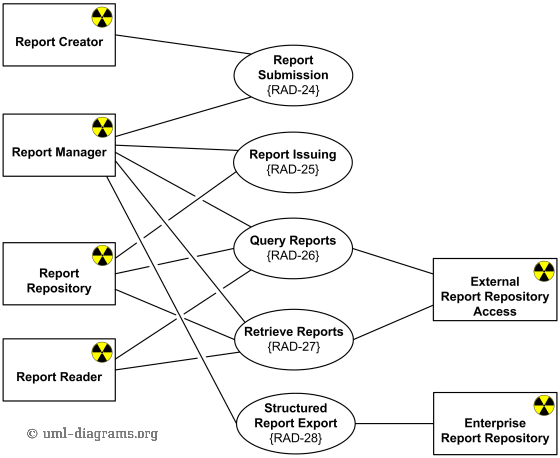Radiology Diagnostic Reporting
UML Use Case Diagram Example
Integrating the Healthcare Enterprise (IHE) is an initiative promoting the use of standards to achieve interoperability of Health Information Technology (HIT) systems and effective use of Electronic Health Records (EHRs).
IHE publishes the implementation guides called IHE Profiles incorporated in the appropriate IHE Technical Framework after successful testing and deployment in the real-world healthcare settings.
The Simple Image and Numeric Report (SINR) [IHE Radiology Integration Profile, IHE RAD TF Vol. 1, Rev. 11.0] facilitates the growing use of digital dictation, voice recognition, and specialized reporting packages, by separating the functions of diagnostic reporting into discrete actors for creation, management, storage and report viewing. Separating these functions while defining transactions to exchange the reports between them enables a vendor to include one or more of these functions in an actual system.
The IHE Technical Framework (TF) identifies IHE Actors - functional components of a healthcare enterprise from the point of view of their interactions in distributed healthcare environment. On the example diagram below we show IHE Actors as UML actors notated as classifiers marked with radiology icon.
IHE TF also specifies a set of coordinated, standards-based interactions between IHE Actors, called IHE Transactions. Transactions transfer required information through standards-based messages. On the example diagram below we show IHE Transactions as UML use cases.
IHE Diagnostic Report Process Flow describes the typical process flow related to the diagnostic reporting. The IHE transactions of this flow are RAD-24 through RAD-27.
In the initial stage of diagnostic reporting, a reading physician records a diagnosis by generating a draft DICOM Structured Report (SR) object. In the Report Submission transaction, Report Creator actor transmits that DICOM SR object in an initial draft or final state to the Report Manager. The Structured Report object is required minimally to conform to the template TID 2000. DICOM Structured Reports offer the capability to encode arbitrarily structured diagnostic report data.
The Simple Image Report allows documents with multiple sections (with headings) containing report text and references to relevant images. Some text items of these documents may also be related to specific images. This allows a reading physician to identify one or more images from which their conclusions were inferred. This kind of reports (aka "content pattern") should use the DICOM Basic Text SR Information Object Definition (IOD) and Basic Image Diagnostic Report Template (TID 2000 in DICOM 2011 PS3.16).
The Simple Image and Numeric Report is similar to the Simple Image Report but allows the addition of numeric values. This enables a diagnosis to include measurements and other numeric values. This kind of reports should use the DICOM Enhanced SR IOD and Basic Image Diagnostic Report Template (TID 2000 in DICOM 2011 PS3.16).

Radiology diagnostic reporting UML use case diagram example
for Simple Image and Numeric Report (SINR) IHE Radiology Integration Profile.
Reports are processed and modified by the Report Manager IHE actor. This involves adding and changing report data as well as verifying draft reports. In all cases, any change in the report content by the Report Manager leads to the creation of a new DICOM SR object. At any time, the Report Manager can transmit reports to the Report Repository for external access, but at a minimum the final report must be sent to the Report Repository.
In the Report Issuing transaction, the Report Manager transmits either an unchanged draft DICOM SR or a new modified DICOM SR to the Report Repository. The Report Manager handles all state and content changes to DICOM Structured Reports, and with each change new DICOM Structured Report objects are created and may be stored in the Report Repository.
The Report Repository provides permanent storage of DICOM Structured Reports. It also allows reports to be queried and retrieved throughout the enterprise by Report Readers.
The Report Reader provides a user interface to view DICOM Structured Reports. DICOM SRs are queried and retrieved by the Report Reader from the Report Repository or the External Report Repository Access.
The External Report Repository Access actor is a gateway to obtain other enterprise department reports, such as Laboratory and Pathology, from within the Imaging department.
In the Structured Report Export [RAD-28] transaction, the Report Manager transmits verified Structured Reports as unsolicited HL7 observations to the Enterprise Report Repository. The Enterprise Report Repository receives diagnostic reports in HL7 format. The Report Manager is responsible for mapping DICOM SR to HL7.